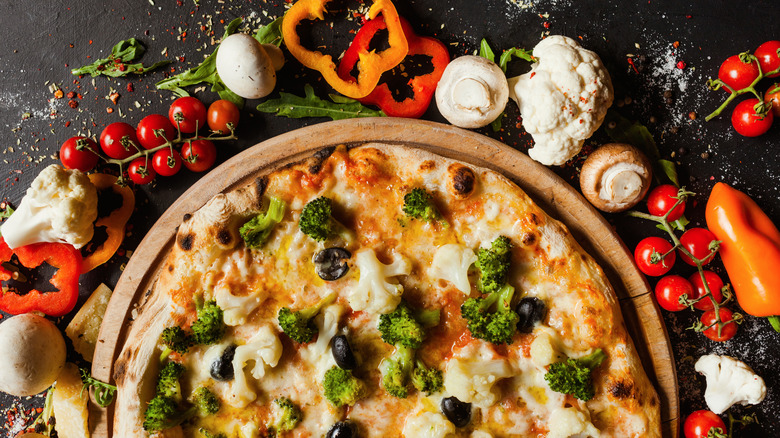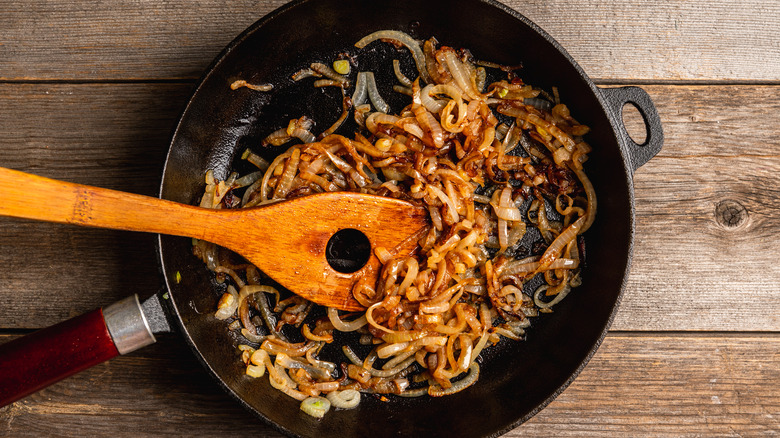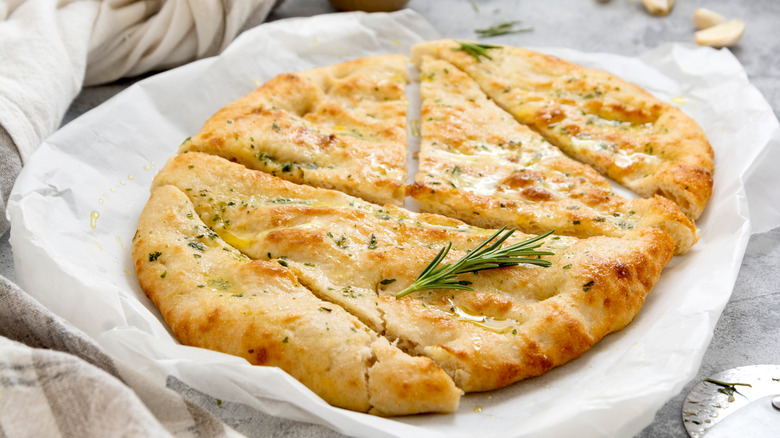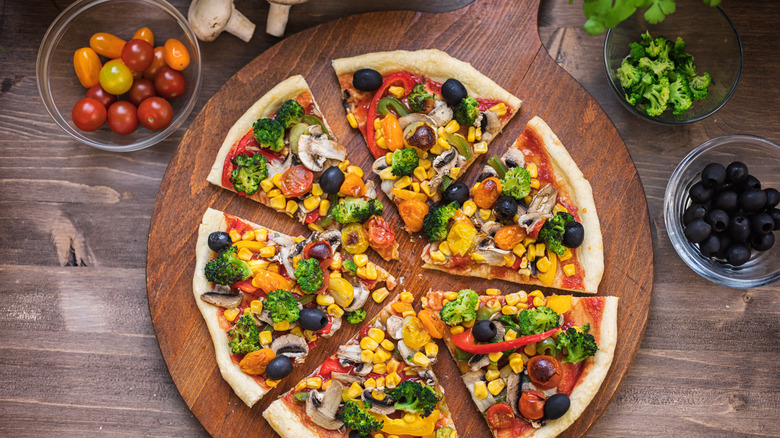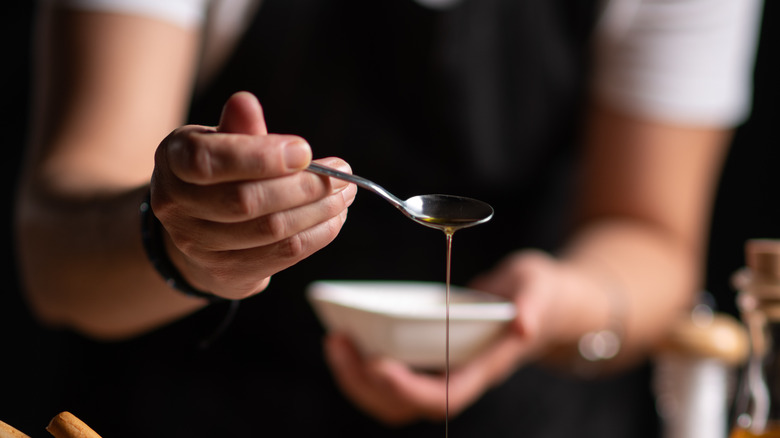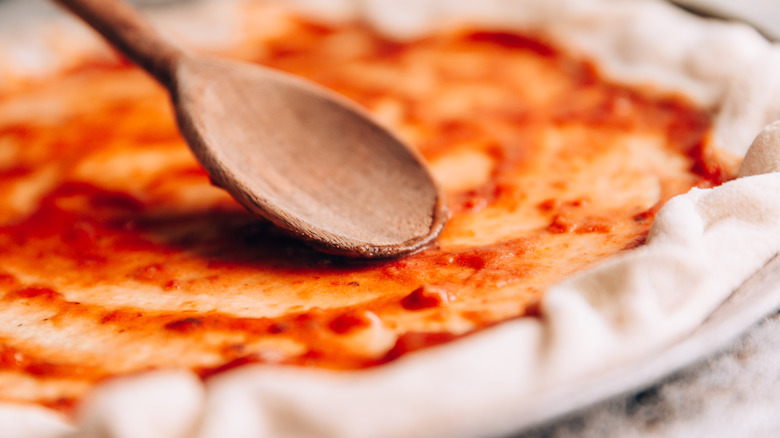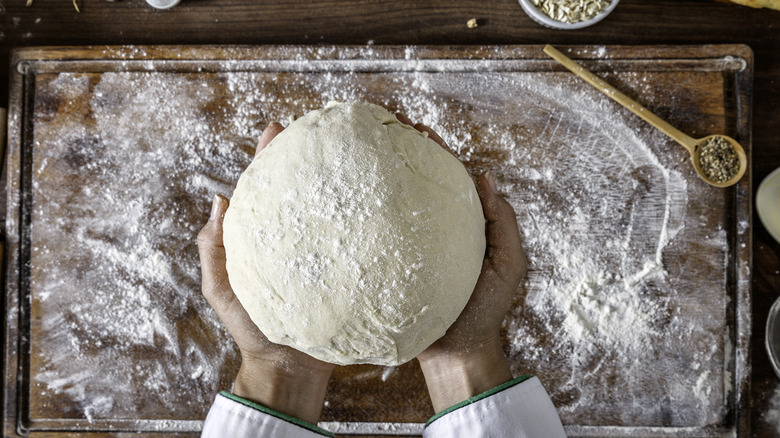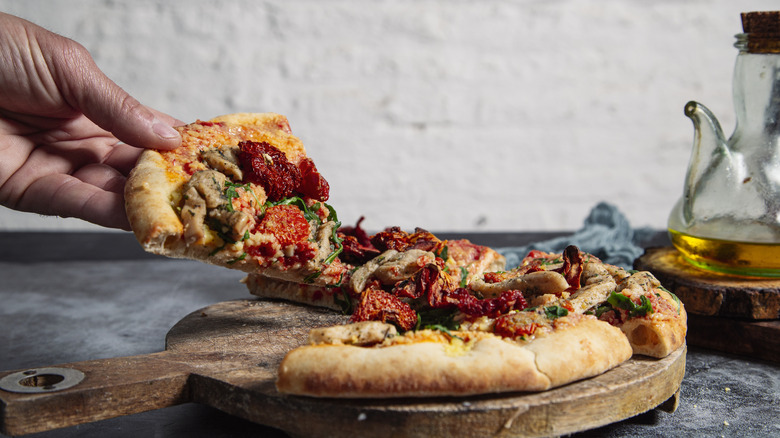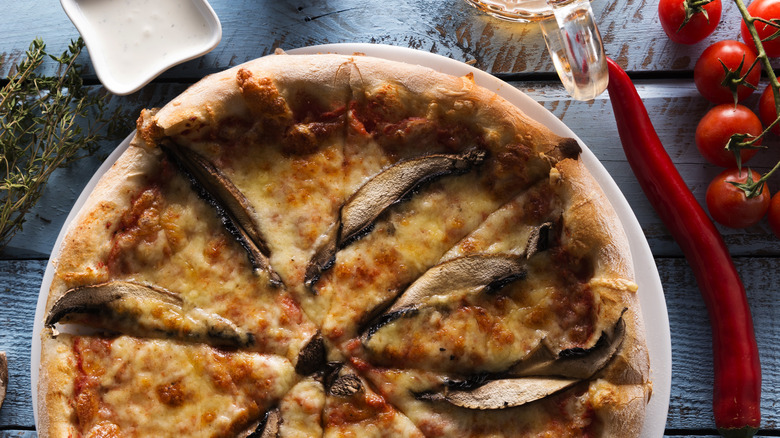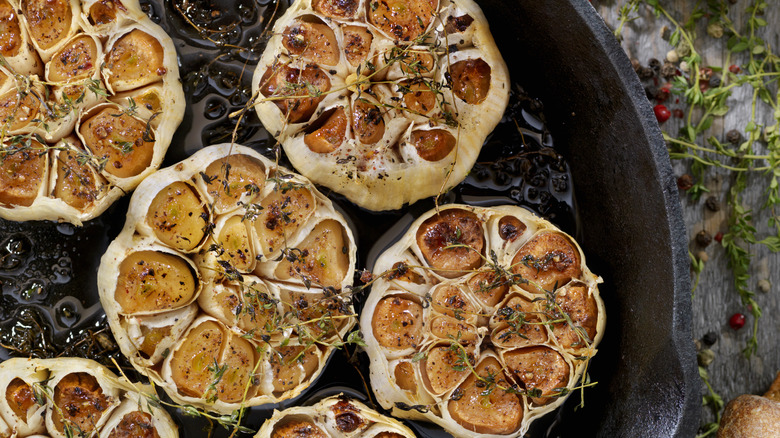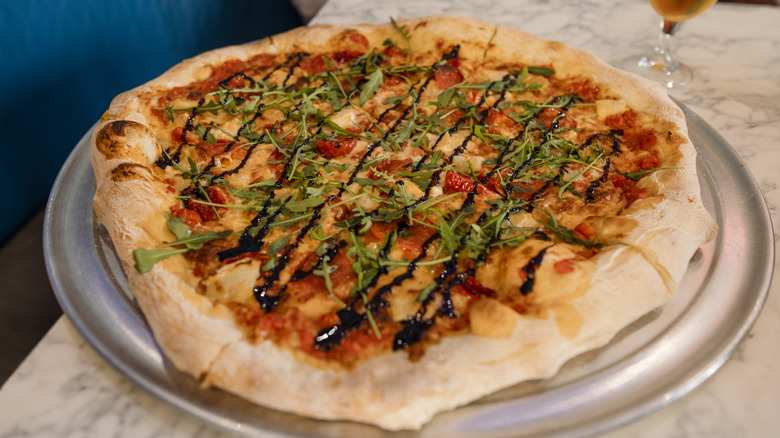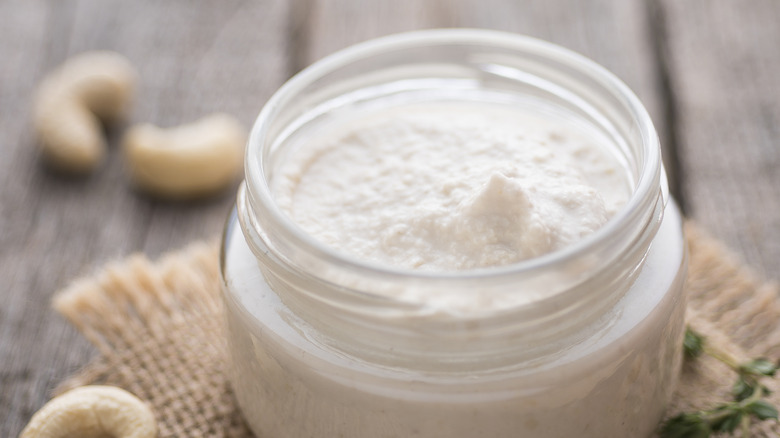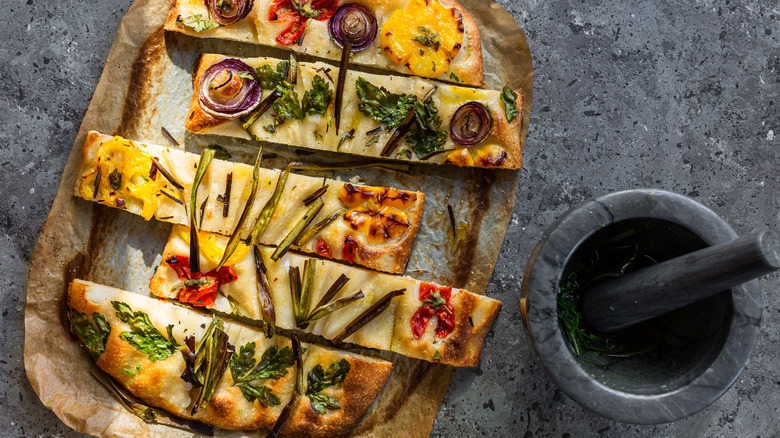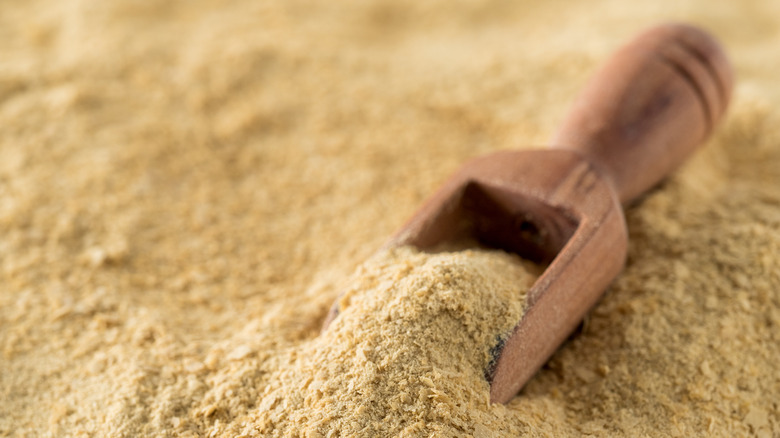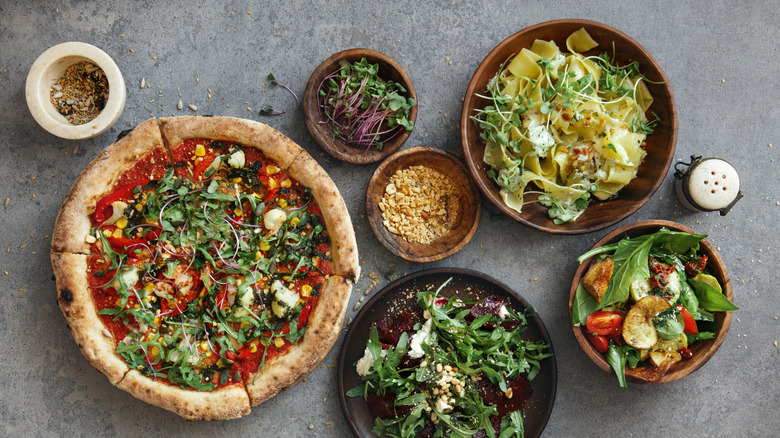14 Tips For Making A Flavorful Vegan Pizza
It may seem like the foundation for pizza is good crust, sweet tomato sauce, and, of course, melty, bubbly cheese. And who doesn't love that timeless combination of flavors? Well, vegans are no exception to pizza's magical spell, but finding or making a good cheese-less pizza can sometimes feel like a fool's errand. But, with a little research and applying the right tips for making a flavorful vegan pizza, the outcome can wow your tastebuds and have you questioning the necessity of cheese altogether. Though if you're still partial to cheese (as are many people) we've discovered some incredible alternatives that will leave your tastebuds singing.
Vegan pizza doesn't have to be difficult or complicated: Follow these tips and tricks for making it the best pizza (vegan or not) that you've ever had. It sounds like it's time for us to toss some dough and soak some cashews. Let's get started.
Add a layer of caramelized onions
Cheese has a mellow sweetness to it that people just can't seem to get enough of. And that melty, butter texture? Sign us up for more. When creating a pizza without cheese, it's important to replace some of that flavor and mouthfeel. And what better way to add buttery moisture and sweetness than with caramelized onions?
For foolproof caramelized onions, take your time during the cooking process. Start by slicing the onions thin, and cooking them in vegetable broth until they are translucent. Continue to deglaze the pan with liquid to free any browned and caramelized bits that have stuck to the bottom. If you desire, add balsamic vinegar or a little vegan butter to the pan for additional flavor. Keep those onions cooking until they are sweet as can be and have a sticky, soft texture. Remove them from the heat, and use them as a base of flavor on your pizza, below the sauce. Smear them right on top of the crust, and be generous with your proportions. Caramelized onions can add texture and flavor to both red and white pizzas, so don't hold back.
Flavor the crust
Since cheese isn't going to be the star, steal the show with a flavorful crust. In fact, there are plenty of ways to add more flavor to pizza crust, so choose the best one to suit your pie, or try them in combination. A simple way to give your crust a flavorful kick is to add herbs and spices to it. That means you can knead them right in before the crust bakes. Consider minced parsley, basil, thyme, or a mixed Italian seasoning. Some like it hot, so give red pepper flakes a chance. Even dried aromatics like garlic or onion powder can go a long way in the flavor department.
An alternative way to flavor pizza crust is by bruising the good stuff on top of the dough before you cook it. We recommend making an oil mixture using extra virgin olive oil, minced or pressed garlic, dried parsley, sea salt, and black pepper and brushing it on using a rubber grill brush. The garlic will cook with the crust, and leave you with a garlic bread-type foundation to layer with sauce, vegan cheese alternatives, and toppings.
Load up on the toppings
If your pie is loaded to the brim with delicious toppings, then who will even notice that the cheese is missing? Will Meyer of Vegan Pizza Land in Easthampton, Massachusetts' favorite toppings include cauliflower, pickles (and not just the cucumber variety), and a variety of sauces. He states, "The reason our pizza stands out is not that it's vegan, but rather that constraint forces a kind of creativity — a sense of possibility — that most restaurants don't have to engage with."
If you're tired of the same-old, same-old olive and peppers toppings, try some gourmet toppings to give your pizza an upgrade. For instance, artichoke hearts can add a buttery tanginess, while fresh arugula can be added after the pie comes out of the oven for a refreshing and peppery crunch. And don't just stop at one or two. Pickled red onions, oyster mushrooms, sun-dried tomatoes, and eggplant could all be star features on your next vegan pizza. In the end, you shouldn't be able to see through the pile of veggies to your vegan cheese or crust.
Finish with EVOO
One of the main allures of a freshly baked pie is those little pockets of melted cheese oil. With a slight hew from the red of the tomato sauce and the concentrated salty flavor, it's one of those elements that a plant-based pie just can't quite provide. However, there are ways to get rather close and mimic that familiar mouthfeel we all love. Napkin dabbers, we hear you, but pizza grease is too important to give up.
Even if you opt for cashew cream or a minimally processed option unlike an oil-based vegan cheese, you always have your best friend, olive oil, to turn to. Some of the best, high-quality, finishing olive oil brands are jam-packed with flavor and can add more than just a familiar, greasy mouthfeel. Good olive oil should have floral and fruity undertones, with a fresh and lingering flavor. Consider infused olive oils for specialty pizzas. Simply bake your pie and finish with a drizzle of that liquid gold, or choose to douse it on before it goes into the oven to bake.
Double up on sauces
So you're not using meat or cheese in your pizza recipe? Then we feel you have free range to double up on sauces. And although most people stick to the classic tomato sauce, there are plenty of options out there, including a plethora of sauces for dipping your pizza crust into when all is said and done.
A famous pairing, pesto (be sure your recipe is vegan), and tomato sauce can play nicely on any pie. Either use a spoon to swirl the two together, or use tomato sauce as your base and dollop your vegan pesto atop your vegan cheese. Other seriously good combinations like ranch and barbecue sauce, or arrabbiata and cashew cream can be mixed or layered as well. If you've got a picky eater in the house, consider topping the pizza with one of the sauces, and drizzling the other one on afterward, or serving the slices with little bowls of dipping sauce.
Use a quality dough
Yes, it's possible to buy a store-bought dough or crust and flavor it to the hilt with aromatics, spices, and oils, but a good foundation will always hold a sturdier structure. Consider following some top tips you need when making homemade pizza crust, and take your time to be sure it really sings. From using beer to allowing the dough to rest, these extras may take a little more finesse than you're used to, but we can assure you that for the added quality, it's worth the extra effort.
Will Meyer uses a sourdough base, which has a slight tanginess to it, and a nice airy interior, "The secret to dough is being attentive to it. There are a lot of ways to build flavor in the dough — seasoning, blending flours, all of which can be pretty subtle. To get a crispy crust, you need properly fermented dough and a hot pizza stone!" And who can resist a crust that's crispy on the outside, and fluffy on the inside, as well as flavorful?
Use vegan meats
We often hear meat lovers asking why vegans like their faux meat shaped or in the appearance of real meat. And the answer is plain and simple: Vegans didn't stop eating meat because they don't like the flavor, it just doesn't align with their ethics, or in the case of plant-based goers, it doesn't align with their definition of health. So if they can get their hands on something that tastes and looks like the real thing, but hasn't harmed any animals in the process, then why not indulge?
When it comes to building a vegan pizza, load up on the vegan version of your old favorites. Because of the increasing number of vegans, and the high demand for quality vegan meat products, the vegan meat industry is booming. In fact, there are some quality plant-based meat brands that every vegan and vegetarian should know about, beyond just Impossible and Beyond Meats. If you're wary of the processed stuff, or it creeps you out, try making your own from mushrooms, tofu, or jackfruit.
Experiment with vegan cheese
While some vegan cheese taste and look a little like plastic (hey, it's a work in process), there are some brands out there that are crushing the game. We are starting to see more artisanal and specialty cheese that can make vegans feel like they can genuinely indulge again. No longer excluded from the world of charcuterie boards or cheese and wine tastings, the universe of dairy-less cheese is opening up, and the pizza-loving community couldn't be happier.
Try and choose wisely from some of the best vegan cheese brands, and be strategic about finding a meltable cheese. In fact, some vegan cheeses are specially made for pizza, like Miyokos pourable plant-milk mozzarella. These are designed to bake on pizza dough, taste like a mild pizza mozzarella, and bake and bubble like the real thing. In the end, there's nothing worse than topping your master creation with a plant-based cheese that simply hardens as little shreds or begins to burn before the crust is halfway cooked. Do your research, and load up on the brands you love.
Add roasted garlic spread
For those who haven't discovered the wonders of oven-roasted garlic yet, then it's time to get cooking. This mashable, spreadable, fragrant culinary wonder can bring almost any savory dish to the next level. It's quite simple to make and is sometimes referred to as garlic confit.
For a simple oven-roasted garlic recipe, cut the very top of a whole head of garlic, exposing a little bit of each of the cloves. Heavily douse it in olive oil so it soaks into all of the nooks and crannies. Add a little sea salt and cracked pepper if desired, and then wrap the bulb in foil to prevent it from burning. Roast in the oven at 375 Fahrenheit for about 45 minutes, and then let it cool before squeezing out the now-soft bulbs into a bowl.
Mix the garlic paste until smooth, adding additional salt if you desire, and smear right onto your pie crust before adding your sauces, alternative cheeses, and toppings. This buttery layer of garlic will give your vegan pizza the extra edge that it needs and will create a more familiar, creamy mouthfeel.
Drizzle with a dressing after it's cooked
It's very rare to find a pizza that tastes exactly like the dairy-rich real thing, and that's because it's not. Thats okay. Make your vegan pizza sing in other ways. One element that vegan pizza seems to be missing is the nip that cheese brings to the table. You can always add acid to your homemade cashew cream sauce or sprinkle on nutritional yeast, but another way to achieve a similar flavor is by drizzling on a dressing after the pizza comes out of the oven.
Salad dressing tends to have an acidic pop, whether through the addition of vinegar or citrus juices. And while you may be questioning the duo, salad dressing pairs particularly well with vegetables, grains, and nuts, which are typically at the base of vegan pizza. Consider Italian dressing, balsamic vinegar, balsamic reduction, vinaigrettes, or even creamy dressings. Vegan ranch, for instance, makes a creamy and delicious topping, especially paired with a heavily veg-loaded pie.
Use homemade cashew cream
Like Meyers, we recommend using cashew cream for a hearty and flavorful vegan pizza. In fact, cashew cream or cashew cheese does wonders in replacing dairy products across the board, as there are endless uses for cashew cream in your cooking. While some processed vegan cheese can have an almost plastic-like appearance or flavor and tend to burn rather than melt, cashew cheese is a reliably safe bet.
Vegan Pizza Land makes its own cashew cheese that even melts just like the dairy version. This is perhaps one of the biggest differences between a dedicated vegan pizza restaurant and your typical pizza shop that has vegan options available. Homemade cashew cheese will always win the quality and flavor battle against generic store-bought brands. For those new to cashew cheese, start with a base of raw, soaked cashews. Blend them with water, lemon juice, garlic powder, nutritional yeast, a touch of sweetener, salt, and pepper until you have a thick, creamy batter that's hearty enough to be spreadable. Add olive or unflavored coconut oil to help it melt. It should be creamy and smooth when all is said and done. Dollop or spread it right over the sauce, bake, and enjoy.
Top with fresh herbs
While your crust, sauce, and even veggies may be seasoned beyond belief with herbs, that doesn't mean you have to put your brakes on just yet. Once that pie comes pipping-hot out of the oven, load it up with minced, fresh herbs. The key is to use crisp herbs that have been washed in cold water and cut with a sharp knife to avoid bruising.
Basil is a universally loved classic for pizza. It's sweet, a little spicy, and quite aromatic. Basil pairs well with classical flavors, as well as any roasted vegetable or white pizza. Cilantro can be used atop any Southwest or Mexican-themed pizza, especially those loaded with corn, vegan chorizo, or spicy peppers. Rosemary can be used on white pizzas or artisanal pizzas, typically featuring just a few key top-tier toppings, as the herb carries a strong flavor. Sage is another favorite that pairs well with white pizzas, as well as those featuring mushrooms or potatoes. Parsley can be used as a citrusy refreshing topping to any pizza, especially those with raw vegetable toppings.
Sprinkle with nooch
Nutritional yeast is a staple for vegans, plant-based individuals, and those with lactose intolerance but who love the flavors of cheese. It's simply a deactivated yeast that comes in sprinkle-able, yellow flakes. These flakes closely resemble the nip of aged cheese and share a salty, nutty similarity as well. It's a great way to add flavor to a recipe without loading up on salt and can make sauces extra creamy. It is often used in soups, sauces, and spreads, and nutritional yeast can take even a dairy-based grilled cheese to the next level, so imagine just want it can do for non-dairy foods.
That familiar nip can go a long way when added to the pizza. It can be sprinkled right on top after baking, or mixed into your dairy-free cheese of choice. Consider using it in your vegan cashew cream or cheese, as it dissolves easily and will lose any flakey or papery-like texture that it has almost instantly.
Push the boundaries
Who says you have to use tomato sauce and cheese? Try a breakfast pizza with vegan sausage and JUST eggs. Why not a vegan cream cheese and fruit pizza with a cinnamon crust? The world is our vegan oyster, and it's time we took advantage of this. Traditional toppings can be comforting, but top chefs didn't get to where they are by following the rules. You're already breaking boundaries by removing cheese from pizza, so why not go all the way?
Meyer agrees and feels that variety is the spice of life. He states, "The menu changes every week. Mike (his partner) is Korean-American, so we love doing Korean-inspired pies, like cauliflower bulgogi and kimchi [vegan] sausage. We love all of the local farmers, and getting to use their produce with the seasons; this time of year, we're hitting ramps and asparagus." If it grows from the ground, then it belongs on vegan pizza. Just be sure to pair your vegetables and spices with intention. For instance, pineapple might taste delicious on a cashew cream and barbecue pizza with red onion, but may not pair as beautifully with asparagus and spinach.
